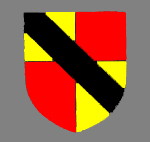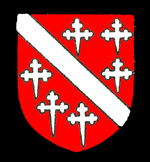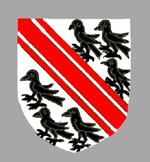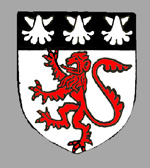
Coat of arms of the Barony of Bedford
Volume III of The Victoria County History for Bedfordshire, published in 1912, gives a detailed history of Willington Manor as far as it was then known. The Domesday Book of 1086 states that Hugh de Beauchamp, later Baron of Bedford, held a manor of ten hides in Willington. The Barony of Bedford remained the manorial overlord until 1265 when John de Beauchamp was killed at the Battle of Evesham fighting for Simon de Montfort against King Henry III. The barony was then divided amongst his three sisters.
Maud, wife of Roger de Mowbray received Willington Manor, amongst other property. Her husband died the following year, 1266, and she married Roger Lestrange who held Willington until his death in 1311, having outlived Maud.

The Mowbray family coat of arms
Roger Lestrange was succeeded by Maud's grandson John de Mowbray, who settled the manor for life on William de Braose, having married his elder daughter Aliva. John de Mowbray was hanged at York in 1322 for joining in the Earl of Lancaster's rebellion against King Edward II (1307-1327). His lands were forfeited to the Crown and were given to the king's notorious and rapacious favourite Hugh le Despenser the younger.

le Despenser coat of arms
On the accession of King Edward III (1327-1377) the de Mowbray estates were restored to his son, another John, who acknowledged the rights of his mother's new husband Sir Richard de Peshale. Evidently the two did not get on as de Peshale filed complaints of trespass against de Mowbray in 1329 and twice in 1332, for entering onto Willington Manor. In 1329 he stated that de Mowbray's raiders drove off 24 horses, 60 oxen, 12 cows, 500 sheep, 200 swine as well as de Peshale's goods - over £300 in all. De Peshale also complained that the raiders mowed his crops, fished his stews (fish ponds), carried away the fish and crops with other goods such as sacks of wool and grain and assaulted his servants. De Mowbray died in 1362 and his second wife, Elizabeth, succeeded to Willington Manor.
Contention evidently ran deep in the family. In 1366 John de Mowbray's son, another John, complained that his step-mother Elizabeth had destroyed trees, dug up land and allowed the manorial buildings to fall into decay. These buildings included two courts, two dwellings, four rooms, two kitchens (usually separate buildings at that date due to the risks of fire), two granges (manor houses in agricultural estates belonging to religious houses), various outbuildings, two houses called "Yathous", two dovecotes and a chapel. The complaint also lists thousands of trees including oak, ash, elm, hazel, white thorn, apple, pear, plum and cherry trees. Elizabeth replied that one dwelling was pulled down because it was unsafe, another blown down in a gale and cottages pulled down because the tenants had died of plague, presumably in 1362 which was a plague year in Bedfordshire. Nevertheless John recovered damages against Elizabeth of £938/18/-.

The Howard family coat of arms
John died in 1368 and Elizabeth in 1376 when the heir, John's son John, was a minor. John the younger became Earl of Nottingham at the coronation of King Richard II (1377-1399) in 1377 and was succeeded by his brother Thomas, subsequently Duke of Norfolk, in 1383. Norfolk was banished by Richard II shortly before the king's murder in 1399. He died shortly afterwards and his son Thomas was a minor. He was executed for high treason in 1405 and the manor passed to his brother John who died in 1432. The last Mowbray to own Willington was Anne. She married the younger son of King Edward IV (1461-1470 and 1471-1483), Richard of York, one of the princes in the tower. After Richard's murder Willington manor passed into the Howard family, whose estates were forfeit after the Battle of Bosworth when usurper Henry VII (1485-1509) defeated and killed King Richard III (1483-1485). Henry granted Willington Manor to John de Vere, Earl of Oxford. However, in 1489 Henry released Thomas Howard, Earl of Surrey, from prison and his estates, including Willington, were restored to him. He became Duke of Norfolk in 1514 after victory against the Scots at the Battle of Flodden Field. His son, Thomas, Duke of Norfolk, sold Willington in 1529 to John Gostwick whose ancestry in Willington can be traced back to 1286.

The Gostwick family coat of arms
Gostwick acquired land from dispossessed religious houses to add to his manor and even entertained King Henry VIII at Willington. He died in 1545 and was succeeded by his son, who died in the same year, then by his brother William who died in 1549. William's son, another John, succeeded him. His son, another William was High Sheriff of Bedfordshire in 1595 and was created a baronet by King James I (1603-1625) in 1611. His grandson Edward was deaf and dumb but married, succeeded as Lord of the Manor and had children, his second son William being High Sheriff in 1679/80 and Member of Parliament for Bedfordshire from 1698 to 1713. His grandson William sold Willington Manor in 1731 to Sarah, Duchess of Marlborough, widow of the great general, the victor of Blenheim, she died in 1744.

The Russell family coat of arms
In December 1774 the Duke of Bedford purchased Willington Manor from the Duke of Marlborough for £100,000, completing the manor's ownership by three separate ducal families; £50,000 was paid at once and a further £50,000 in October 1778 to complete the conveyance. The manor remained with the Dukes of Bedford until 1902 when it was sold to George and James Keeble of Peterborough. The manorial estate was quickly broken up with Colonel Frank Shuttleworth of Old Warden and Mark Young of Sandy being the principal landowners. A succession of Law of Property Acts in the 1920s abolished manorial fines and incidents as well as copyhold land tenure, thus abolishing manors in practically all but name.